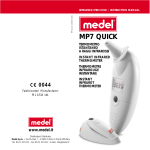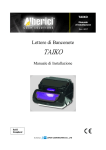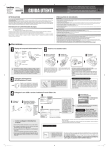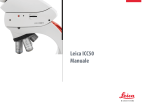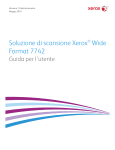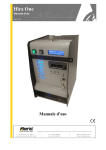Download Art. 72TL
Transcript
Art. 72TL 2 1 1 3 4 2 3 6 12 7 4 5 9 10 11 2 8 4 8 9 10 3a 3b 3c 4 7 4 5 ITALIANO ISTRUZIONI PER L’USO Per la vostra sicurezza Prima di usare questo apparecchio leggere attentamente le seguenti istruzioni e rispettare le regole e le norme per la prevenzione degli infortuni vigenti nel luogo d’impiego. Questo apparecchio è costruito nel rispetto dello stato dell’arte e delle regole tecniche di sicurezza. L’uso dell’apparecchio è consentito solo - per l’uso previsto, - in perfetto stato tecnico di sicurezza. Eliminare immediatamente i guasti che pregiudicano la sicurezza. Classificazione del laser LASER RADIATION DO NOT STARE INTO BEAM Radiazione laser Non guardare il raggio Laser classe 2 Class 2 laser Max. Output power ≤ 5 mW @ 650 nm Class 2 laser EN 60825-1: 1994+A1: 2002+A2: 2001 Max. potenza di uscita ≤ 5 mW @ 650 nm Laser classe 2 EN 60825-1: 1994+A1: 2002+A2: 2001 L’apparecchio è conforme alla classe di laser 2, fondata sulla norma EN 60825-1: 1994+A1: 2002+A2: 2001. L’occhio che guarda casualmente e brevemente il raggio laser è protetto dal riflesso di chiusura della palpebra. Questo riflesso di chiusura può essere tuttavia pregiudicato da medicinali, alcool o stupefacenti. Questi apparecchi possono essere impiegati senza altre misure di protezione. Come nel caso del sole, è opportuno evitare tuttavia di guardare direttamente nella fonte di luce. Non rivolgere il raggio laser verso le persone. La radiazione laser può essere fonte di accensione per atmosfere potenzialmente esplosive e materiali infiammabili. Istruzioni per la sicurezza - Tenere i bambini lontano dagli apparecchi laser. - Non rivolgere il raggio laser verso persone o animali. - Non guardare mai il raggio laser direttamente o con strumenti ottici. Impedire che terzi possano guardare con strumenti ottici il raggio laser. - Fare passare il raggio laser possibilmente sopra oppure sotto l’altezza degli occhi. - Prima della messa in funzione, controllare se l’apparecchio presenta danni visibili. Non mettere in funzione apparecchi danneggiati. - Fare riparare l’apparecchio solo da personale specializzato autorizzato. In caso di inappropriata apertura dell’apparecchio, può verificarsi un’emissione di raggio laser superiore alla classe 2. - Non impiegare l’apparecchio in ambienti con atmosfera potenzialmente esplosiva. - Nei lavori su scale a pioli, evitare posizioni pericolose. Provvedere sempre ad assumere posizioni sicure ed a mantenere continuamente l’equilibrio. Danni materiali! - Non utilizzare l’apparecchio sotto la pioggia. - Quando si porta l’apparecchio da un freddo intenso in un ambiente più caldo e viceversa, prima dell’uso lasciare acclimatare l’apparecchio. - Per la pulizia dell’apparecchio utilizzare solo panni puliti e morbidi. - Per la spedizione dell’apparecchio o per metterlo fuori servizio per un lungo periodo, isolare le batterie oppure rimuoverle dall’apparecchio. Danni all’ambiente! - Smaltire apparecchio e batterie secondo le direttive specifiche nazionali rispettivamente in vigore. In caso di dubbio, interpellare il produttore o il fornitore. Descrizione (Fig. 1) 1 2 3 4 5 6 7 8 9 10 11 12 Misuratore laser di angoli Interruttore ON/OFF Livella a bolla Manopola di regolazione livella Foro di uscita del laser Appoggio di posizionamento Coperchio scomparto batterie Base della livella Vite di regolazione per la base della livella Vite per la base della livella Manicotto di prolunga Mirino laser Caratteristiche tecniche Precisione ±0,6 mm/m Temperatura d’esercizio -1° _ 40°C Classe del laser 2 - Indirizzare il raggio laser verso superfici molto riflettenti come specchi, acciaio cromato, pietre lucidate o simili. Lunghezza d’onda del laser 650 nm Potenza laser ≤ 5 mW - Sono vietate le manipolazioni o modifiche all’apparecchio. Non rendere inefficaci i dispositivi di sicurezza, né rimuovere targhe di avviso e pericolo. Alimentazione corrente del laser 2 x 1,5 V (AA) Peso 450 g 6 ITALIANO Utilizzo (Fig. 3a - 3c) Utile per la posa di piastrelle o di parquet, per la squadratura del locale e per impieghi in verticale come la costruzione di pareti a secco. Come inserire e cambiare le batterie (Fig. 4): Attenzione! Prima di inserire le batterie assicuratevi sempre che il laser sia spento! Aprite il coperchio del vano delle batterie (7), come mostrato nella Fig. 4, ed inserite le batterie in dotazione. Nel far questo fate attenzione alla giusta polarità delle batterie. Utilizzate esclusivamente batterie alcaline al manganese. Quando cambiate le batterie non utilizzate batterie di produttori diversi. Inoltre fate attenzione all’uguale capacità delle batterie. Secondo la Direttiva europea 2002/96/CE sui rifiuti di apparecchiature elettriche ed elettroniche e sua conversione nel diritto nazionale, gli elettroutensili dimessi devono essere raccolti separatamente ed avviati ad un riciclaggio ecologico. Avvertenza: Informarsi presso il rivenditore specializzato sulle possibilità di rottamazione. Smaltire le batterie secondo le norme nazionali rispettivamente in vigore. Accensione (Fig. 1): Per accendere il laser, premete una sola volta l’interruttore di ON/OFF (2). Spegnimento (Fig. 1): Per spegnere il laser, premete due volte l’interruttore di ON/OFF (2). Utilizzo senza base della livella (Fig. 1): Posizionate l’appoggio (6) nel punto di inizio dell’angolo. Regolate lo strumento servendovi della manopola di regolazione della livella (4) e della bolla (3). Mettete in funzione il tracciatore laser. Adesso potete proiettare le linee esatte dell’angolo. Utilizzo con base della livella (Fig. 1/2): La base della livella serve a compensare irregolarità di una certa entità della superficie di appoggio. Avvitate a tal fine le viti di regolazione (9) e la vite (10) nei filetti previsti come mostrato in Fig. 2. Posizionate quindi il tracciatore laser sulla base della livella. Eseguite la regolazione preliminare con le viti di regolazione (9) e quella di precisione con la manopola di regolazione della livella (4). Per irregolarità di rilievo avete a disposizione tre manicotti di prolunga (11). Questi vengono semplicemente inseriti nelle viti di regolazione (9) e nella vite (10). Mirino laser (Fig. 1): Utilizzate il mirino laser (12) come aiuto ad indicare oggetti che non potete raggiungere direttamente con il raggio laser. Grazie al film riflettente sulla superficie posteriore la luce del laser è visibile anche a distanze maggiori. Manutenzione e pulizia Tenete sempre l’apparecchio asciutto e pulito. Togliete lo sporco con un panno morbido ed umido. Non utilizzate a tal fine detergenti aggressivi o solventi. Pulite il foro d’uscita del raggio laser ad intervalli di tempo regolari con un bastoncino cotonato. Riparazioni Fare eseguire le riparazioni esclusivamente dal servizio assistenza clienti autorizzata dal produttore. Istruzioni per la rottamazione e lo smaltimento Solo per paesi dell’UE Non gettare elettroutensili nei rifiuti domestici! 7 ENGLISH OPERATING INSTRUCTIONS For your safety Before using the tool, read and follow: - these operating instructions, - the currently valid site rules and the regulations for the prevention of accidents. This tool is state of the art and has been constructed in accordance with the acknowledged safety regulations. The tool may be operated only if it is - used as intended, - in perfect working order. Faults which impair safety must be repaired immediately. Laser classification - Before switching on the tool, check for visible damage. Do not switch on damaged tools. - The tool may be repaired by authorised technicians only. If the tool is opened without authorisation, laser radiation may be emitted which exceeds class 2. - Do not use the tool in an explosive environment. - When working up ladders, avoid an abnormal body posture. Ensure that you have a secure footing and keep your balance. Damage to property! - Do not use the device in the rain. - If the tool is brought from a cold to a warm environment or vice versa, leave the power tool to acclimatise before using it. - When cleaning the device, use clean and soft cloths only. LASER RADIATION DO NOT STARE INTO BEAM Class 2 laser Max. Output power ≤ 5 mW @ 650 nm Class 2 laser EN 60825-1: 1994+A1: 2002+A2: 2001 Laser radiation Do not stare into the beam Class 2 laser Max. Output power ≤ 5 mW @ 650 nm Class 2 laser EN 60825-1: 1994+A1: 2002+A2: 2001 The power tool conforms to a class 2 laser based on the standard EN 60825-1: 1994+A1: 2002+A2: 2001. Eyes must be protected with the eyelid close reflex in case you accidentally glance into the laser beam. However, this eyelid protective reflex may be impaired by medication, alcohol or drugs. These tools may be used without other protective measures. Nevertheless, you should not look directly into the light source, just as you would not look directly at the sun. Do not aim the laser beam at people. A laser beam may be the ignition source for potentially explosive atmospheres and flammable substances. Safety instructions - Keep children away from laser tools. - Do not point a laser beam at persons or animals. Do not look into the laser beam. - Never look into the laser beam either directly or with optical instruments. Use suitable measures to prevent a third party from looking into the laser beam with optical instruments. - If at all possible let the laser beam path run above or below eye level. - Do not point the laser beam at highly reflective surfaces such as mirrors, chromium steel, polished stones, etc. - It is not permitted to tamper with or change the power tool. Do not disable safety devices and do not remove information and warning signs. 8 - If shipping the tool or disconnecting it for a prolonged period, isolate the batteries or take them out of the power tool. Damage to the environment! - Dispose of tool and batteries in accordance with the currently valid national directives. If in doubt, contact the manufacturer or supplier. Layout (Fig. 1) 1 Angle laser 2 On/Off switch 3 Spirit-level 4 Level setting wheel 5 Laser outlet hole 6 Positioning foot 7 Battery compartment cover 8 Level base 9 Setting screw for level base 10 Screw for level base 11 Extension sleeve 12 Laser aiming device Technical specifications Accuracy ±0,6 mm/m Operating temperature -1° _ 40°C Laser class 2 Laser wave length 650 nm Laser output ≤ 5 mW Laser power supply 2 x 1,5 V (AA) Weight 450 g ENGLISH Use (Fig. 3a - 3c) Essential for the laying floor tiles or parquet flooring, for sizing the room and for the building of dry walls. Inserting and changing batteries (Fig. 4): Important! Always make sure that the laser is switched off before you insert the batteries! Open the battery compartment cover (7) as shown in Fig. 4 and insert the batteries supplied. Check that the battery terminals are positioned correctly. Use only alkaline-manganese batteries. Do not mix batteries from different manufacturers. Use batteries with the same capacity. In accordance with the European Directive 2002/96/EG on Waste Electrical and Electronic Equipment and transposition into national law used electric power tools must be collected separately and recycled in an environmentally friendly manner. Note: Please ask your dealer about disposal options!. Dispose of batteries according to the currently valid country-specific guidelines. Switching on (Fig. 1): To switch the laser on, press the On/Off switch (2) once. Switching off (Fig. 1): To switch the laser off, press the On/Off switch (2) twice. Working without the level base (Fig. 1): Place the positioning foot (6) on the starting point of the angle. Align the angle laser with the help of the level setting wheels (4) and the spirit-levels (3). Switch on the angle laser. You can now mark the exact angle lines. Working with the level base (Fig. 1/2): The level base is used to compensate major unevenness on the standing surface. As shown in Fig. 2, screw the setting screws (9) and the screw (10) in the threads provided. Then place the angle laser on the level base. Make rough adjustments with the setting screws (9) and fine adjustments with the level setting wheels (4). Three extension sleeves (11) are provided for extreme unevenness. They are simply plugged onto the setting screws (9) and the screw (10). Laser aiming device (Fig. 1): Use the laser aiming device (12) to help target objects which you cannot reach directly with the laser beam. Thanks to the mirror-finished foil on the rear surface, the laser light is visible over great distances. Maintenance and cleaning Keep the unit dry and clean at all times. Use a soft, damp rag to wipe off dirt marks. Do not use any aggressive cleaning agents or solvents. Clean the laser beam outlet at regular intervals with a cotton wad. Repairs Repairs may be carried out by an authorised customer service centre only. Disposal information EU countries only Do not throw electric power tools into the household waste! 9









